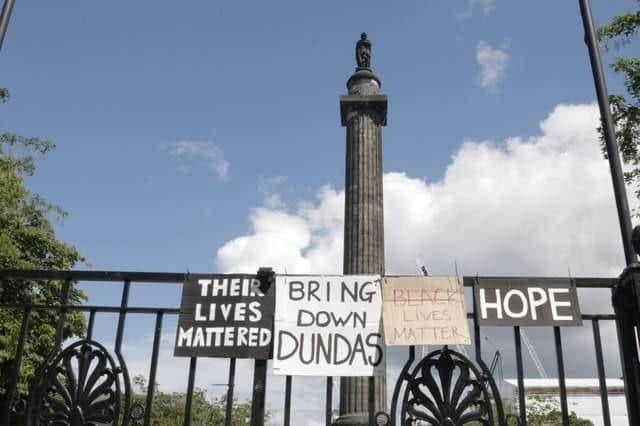Edinburgh statues: Officials recommend removal of Melville Monument plaque on Henry Dundas's role in slavery
and live on Freeview channel 276
Planning officials are recommending councillors agree to the removal of the plaque installed by the council on Edinburgh’s Melville monument referring to the role of Henry Dundas, the first Viscount Melville, in delaying the abolition of slavery.
The new plaque was added to the 150ft monument in St Andrew Square Garden in 2021 after the Black Lives Matter movement sparked calls for the removal of Dundas’s statue. The wording – agreed by council leaders, heritage experts and Professor Sir Geoff Palmer, who led a review of Edinburgh’s links with slavery and colonialism – described Dundas as a "contentious figure" who was "instrumental" in deferring abolition with "more than half a million enslaved Africans crossing the Atlantic" as a result. Dundas (1742-1811) was Home Secretary in 1792 when William Wilberforce was campaigning to abolish slavery. His critics cite a letter he sent which concludes: "I have not time to write more. The time is near five and I must go to oppose the proposals on for abolition of the slave trade."
Advertisement
Hide AdAdvertisement
Hide AdBut some dispute this version of events and say the claims made on the plaque are inaccurate and misleading. They claim Dundas pursued the gradual abolition of slavery as a way of ensuring legislation would be passed and they want the plaque removed.


Bobby Dundas, a direct descendant of Melville, is understood to be behind the planning application to remove the plaque. He is listed as the sole shareholder of the Committee On The Naval Monument To The Memory of The Late Lord Viscount Melville Ltd, which submitted the application. The group claimed the plaque was “inappropriate and does not provide a factual description of Henry Dundas history". Bobby Dundas has previously defended his ancestor's record, arguing he was ‘a politician of vision and integrity’ who had ‘no personal involvement in the slave trade’.
Recommending the application to remove the A3-sized brass plaque, planning officials said: “The proposals have special regard to the desirability of preserving the building and its setting and will not adversely impact on its special architectural and historic interest. The proposals will preserve the character and appearance of the conservation area.” They used similar wording when they recommended approval for the installation of the plaque in 2021.
The plaque, as it is, reads: “This represents Henry Dundas, 1st Viscount Melville (1742 – 1811). He was the Scottish Lord Advocate and an MP for Edinburgh and Midlothian, and the First Lord of the Admiralty. Dundas was a contentious figure, provoking controversies that resonate to this day. While Home Secretary in 1792 and first Secretary of State for War in 1796 he was instrumental in deferring the abolition of the Atlantic slave trade. Slave trading by British ships was not abolished until 1807. As a result of this delay, more than half a million enslaved Africans crossed the Atlantic. Dundas also curbed democratic dissent in Scotland.
Advertisement
Hide AdAdvertisement
Hide Ad"Dundas both defended and expanded the British empire, imposing colonial rule on indigenous peoples. He was impeached in the United Kingdom for misappropriation of public money and although acquitted, he never held public office again. Despite this, the monument before you to Henry Dundas was funded by voluntary contribution from officers, petty officers, seamen and marines and erected in 1821, with the statue placed on top in 1827. In 2020 this was dedicated to the memory of the more than half a million Africans whose enslavement was a consequence of Henry Dundas’s actions."